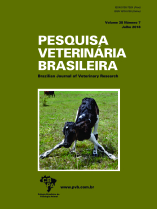 |
|
|
|
Year 2018 - Volume 38, Number 7
|

|
Gastrointestinal and pulmonary nematodes in calves naturally infected in the cities of Botucatu and Manduri, in the Brazilian state of São Paulo, 38(7):1286-1292
|
ABSTRACT.- Cezaro M.C., Neves J.H., Cury J.R.L.M., Dalanezi F.M., Oliveira R.M., Ferreira J.C.P., Neto V.A.K. & Schmidt E.M.S. 2018. Gastrointestinal and pulmonary nematodes in calves naturally infected in the cities of Botucatu and Manduri, in the Brazilian state of São Paulo. [Nematódeos gastrintestinais e pulmonares em bezerros naturalmente infectados nos municípios de Botucatu e Manduri, estado de São Paulo.] Pesquisa Veterinária Brasileira 38(7):1286-1292. Departamento de Clínica Veterinária, Faculdade de Medicina Veterinária e Zootecnia, Universidade Estadual Paulista, Rua Prof. Walter Mauricio Correa s/n, Bairro Unesp, Campus de Botucatu, Cx. Postal 560, Botucatu, SP 18618-681, Brazil. E-mail: bethschmidt@fmvz.unesp.br
This study aimed to determine the occurrence of gastrointestinal and pulmonary parasites in calves and to evaluate seasonal and age patterns in parasitism. For this, we used 140 clinically healthy crossbreed calves (two to 12 months old) that belonged to two private farms in the municipalities of Botucatu (n=53) and Manduri (n=87), São Paulo state, Brazil. The calves were monitored for 12 months (from September 2014 to August 2015). Fecal samples were collected directly from the rectum every three months. Fecal egg counts were determined using the modified McMaster technique with a sensitivity of 50 eggs per gram of feces (EPG). Coproculture was performed on pooled samples to identify Strongylida infective larvae. First-stage larvae of Dictyocaulus viviparus were extracted by a modified Baermann method. The data showed non-normal distribution (Shapiro-Wilk) and the nonparametric Kruskall-Wallis test was employed to evaluate the EPG data by seasons and age groups. Dunn’s post-test was used for multiple comparisons (P<0.05). The calves from Manduri farm showed significantly higher fecal egg counts (P<0.0001) in the winter when compared to other seasons. At Botucatu farm, young calves (2-3 months old) showed significantly higher EPG than old calves (8-12 months) (P=0.01). The prevalence and overall mean of animals positive for Strongylida type-eggs were 81.1% and 340 in Botucatu, respectively, versus 83.9% and 854 in Manduri, respectively. Furthermore, we found Strongyloides spp., Moniezia spp., and Trichuris spp. eggs and Eimeria spp. oocysts. The prevalent genera in all coprocultures in decreasing order were: Cooperia spp., Haemonchus spp., Oesophagostomum spp., and Trichostrongylus spp. First-stage larvae of Dictyocaulus viviparus were found only in Botucatu farm samples throughout the year, except in spring. |
| |
|
|
| |
|
 |